World War 1
US Training Camps
Stateside:
Physical Training at Camp Gordon, GA
Mortar Training At Camp Gordon, Ga. history.army.mil
Infrastructure
The US government created a construction division in May 1917 to construct training camps. The camps were to house 28,000 men each and needed quarters, barracks, administration buildings, hospitals, warehouses, sanitation and mess halls. 32 Camps were housing recruits by September 1917.
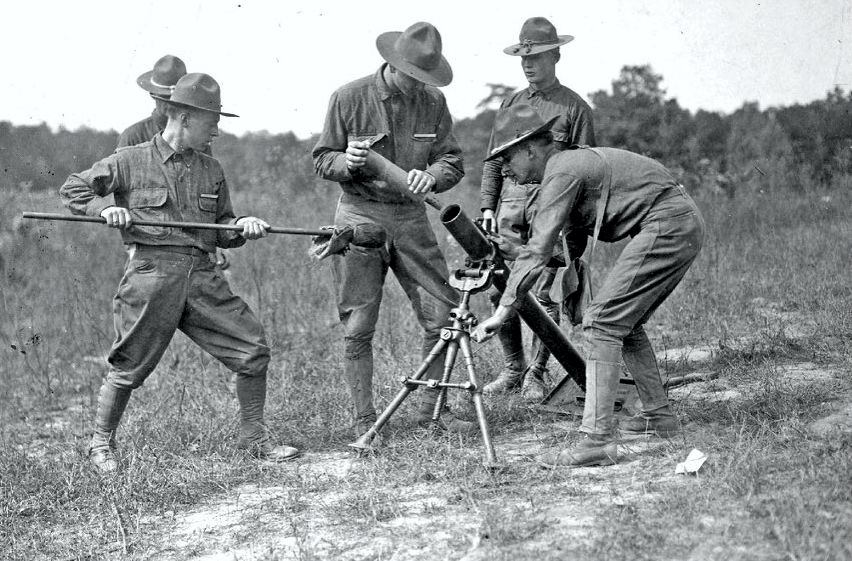
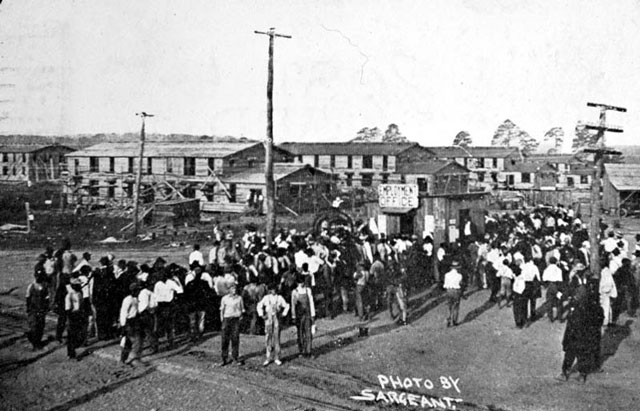
Constructing the employment office at Camp Jackson
Over 1,000 men had been employed in one day to build barracks.
Postcard: Howard G Woody Postcard collection
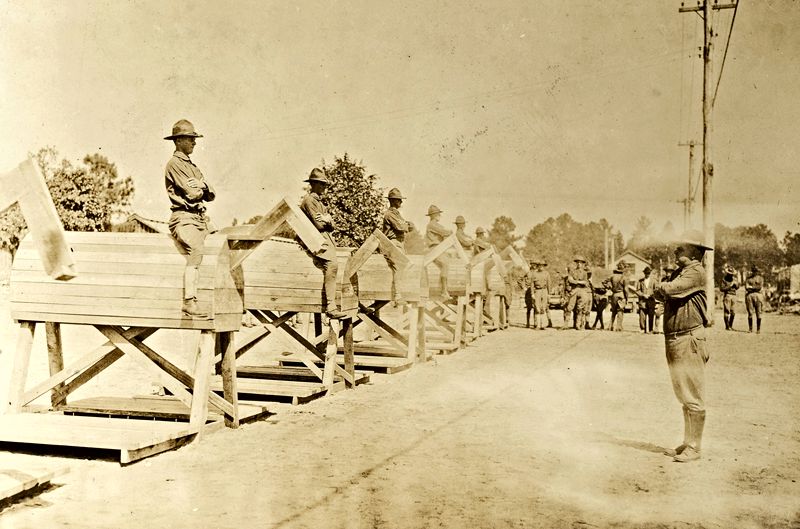
Riding lessons on wooden horses, Camp Jackson, South Carolina
https://www.worldwar1centennial.org/index.php/brookeusa-training-for-war.html
![Camp Jackson Snapshot of the front of the outdoor area around the barracks and training area for the Supply Company of the 9th Regiment [Training] at Camp Jackson, S.C., around 1918 during World War I. Photograph taken or collected by Willie H. Mann of Chatham County, N.C., while he was stationed in the 81st Infantry Division, U.S. Army, at Camp Jackson [circa 1918].](https://wwvets.org/wp-content/uploads/2020/08/TCCamp-Jackson.jpg)
Snapshot of the front of the outdoor area around the barracks and training area for the Supply Company of the 9th Regiment [Training] at Camp Jackson, S.C., around 1918 during World War I. Photograph taken or collected by Willie H. Mann of Chatham County, N.C., while he was stationed in the 81st Infantry Division, U.S. Army, at Camp Jackson [circa 1918].
From Willie H. Mann Photographs, WWI 158, WWI Papers, Military Collection, State Archives of North Carolina, Raleigh, N.C.
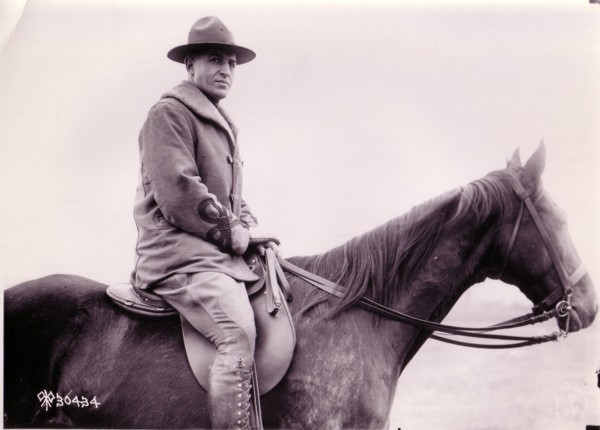
Unidentified COTS Camp Instructor at Camp Taylor, KY on a real horse
America's Freedom photo, courtesy of Indiana War Memorial
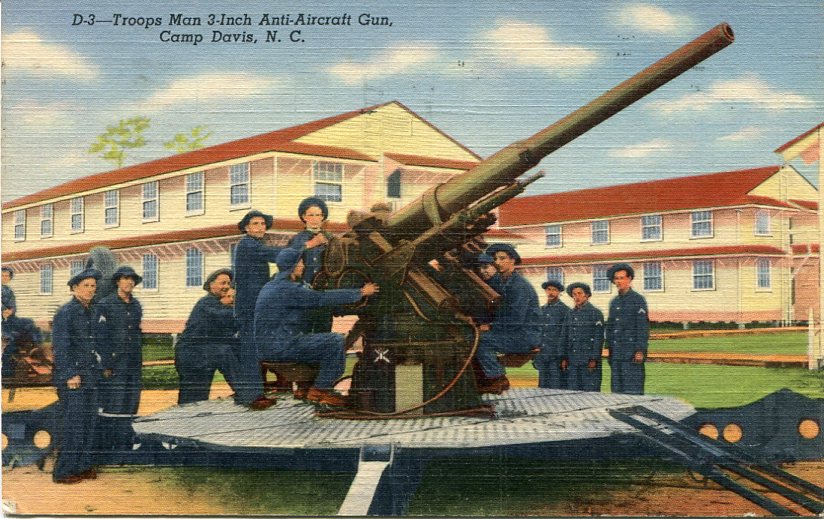
Linen postcard of a group of U.S. Army anti-aircraft artillery soldiers manning a 3-inch anti-aircraft gun at Camp Davis, N.C., during World War II. Postcard contains message from a person named Cecil to Harry Drew of Waterville, Maine, on October 28, 1942 [circa 1940s]
[Postcard by: Curt Teich and Company, Chicago, Illinois, and Service News Company, Wilmington, N.C.].
Camp Jackson
Camp Jackson is located near Columbia, South Carolina, and named for former President Andrew Jackson, housed 42,498 men in training for the 30th & 81st Infantrys and had a larger population than the city of Columbia. 1,519 buildings were constructed in six months at a cost of over eight million dollars.
- 119 Officer's quarters
- 402 Enlisted barracks
- 403 lavatories
- 35 additional mess halls
- 189 stables
- 26 support administrative buildings
- 13 post exchanges
- 12 guardhouses
- 51 storehouses
- 16 shops
- 3 garages
- 102 sheds
- 4 magazines
- 7 civic buildings
- 3 fire stations
- 1 post office
- 1 laundry building
- 1 bakery
- telephone/telegraph building
- 1 sewage disposal building
- 1 base hospital
- and more than 60 buildings.
They also installed a water supply and distribution system, a sewage system, an electrical system, telephone/telegraph lines, roads, and railroad tracks.
https://home.army.mil/jackson/index.php/about/history
Snapshot of U.S. Army Mess Sgt. James W. Bradley, wearing a cook’s uniform, standing outside of a camp building at Camp Jackson, S.C., around 1918 during World War I. Photograph taken or collected by Willie H. Mann of Chatham County, N.C., while he was stationed in the 81st Infantry Division, U.S. Army, at Camp Jackson [circa 1918].
From Willie H. Mann Photographs, WWI 158, WWI Papers, Military Collection, State Archives of North Carolina, Raleigh, N.C.
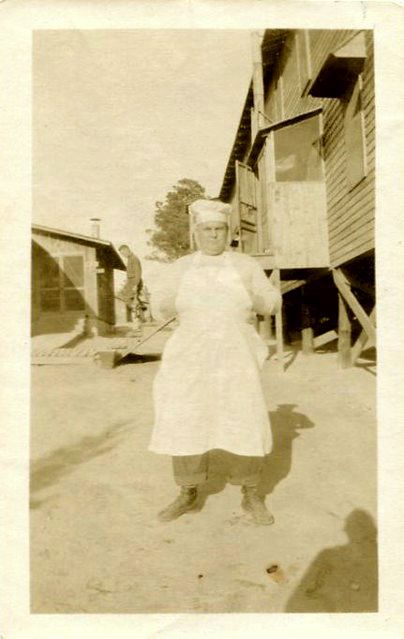
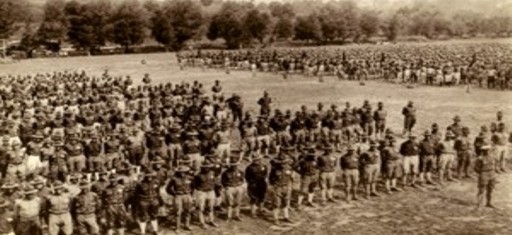
Graduation exercises at Camp Zachary Taylor, Kentucky
National Archives photo CN 2977 IWM
The following is an excerpt from the Sons of Men, Evansville's War Record, (source 41)
Camp Taylor, Kentucky "It was during the roughest winter of many years that the men began their training. For months they drilled in the deep snow of 1917 and 1918. Then they were transferred to the 120th Infantry, 30th Division, Camp Sevier, Greenville, South Carolina, which was a distinctly American division. More than 95% of its personnel was of American-born parents. This division was constituted of National Guard troops of North Carolina, South Carolina and Tennessee and augmented by thousands of selected draft troops from the states of Indiana, Illinois, Iowa, Minnesota, North Dakota, North Carolina, South Carolina and Tennessee."
Soldiers Stories:
Fannie L. Cunningham, Nurse,
Delaware County, Indiana
Camp Merritt: I shall never forget seeing those thousands of fine boys marching day and night to the boats for service at the front, and knowing that many would never return. After the armistice, Camp Merritt became a debarkation point. Such a lot of those poor boys, maimed for life, passed through the camp, and the influenza epidemic made things much worse. Hundreds died in the camp. To me, war is awful and I did not see the worst as I was not oversees.
Aylmer Everett Hendryx, Captain,
Marion County, Indiana
Cited for exemplary service while serving in the Constabulary, Philippines.
I was injured on the 10th day of May 1918, while assisting in the rescue of men of the 81st Div. in a train wreck at Camp Jackson, South Carolina that occurred on that date. Fracture my left anterior tibia and lower end of the patella, resulting in a 25% loss of extension.
Promotions: none “Wrong Politics”
Marion Edward Wood, Private,
Vanderburg County, Indiana
Co. A, 112th Ammunition Train, 37th Div. “I sailed for France on June 28, 1918, from Philadelphia, and was taken sick with measles and taken off the ship Halifax, Nova Scotia on July 2 where I remained in the hospital for 17 days; nine days in Nova Scotia hospital and eight days at the Pine Hill convalescent home and then returned to Hoboken New Jersey for seven days at St. Mary's hospital and sent to Camp Merritt, New Jersey for duty on July 25. On August 19, I was transferred to the detachment of bakers and cooks and remained there until December 11, 1918, was then transferred to Camp Mills, Long Island. There I remained until a few days before I was discharged, going from Camp Merritt and Camp Sherman, Ohio. This is where I received my discharge on March 28, 1918.”
William B. Theising,
Goldstar,
Decatur County, Indiana
William B. Theising was born in Fugit Township on a farm near St. Maurice on May 23, 1897. He received his education and later farmed on his father's farm at St. Maurice until he was called for service to his country on September 4, 1918. He was sent to Camp Taylor and assigned to 13th Co., 4th Training Battery, 159th Depot Brigade. He was there about three weeks when he got sick and died on October 2, 1918, at the age of 21 years, 4 months, and 10 days. His corpse arrived at Greensburg, October 4, one month after he left it, on October 7. He was buried with full military honors at St. Maurice Cemetery, St. Maurice, Indiana.
Hans Ivar Christiansen, Wagoner,
Grant County, Indiana
What were the effects of camp experience upon yourself?
“Developed a fine spirit of comradeship among the boys. The discipline and training aided in the upbuilding of a stronger body, both mentally and physically.
“The above spirit and training enabled us to endure the great hardships of mind and body.
“War is what Sherman said.”
Prior service 18 months with the Danish Navy. Hospitalized in seven different hospitals in France, reason not listed. Battles: Alsace Loraine, St. Mihiel, Meuse-Argonne.
Ada Moore, Army Student Nurse Corps,
White County, Indiana
"Helped care for soldiers returning from France wounded. At Ft. Sheridan, in 1920, 4,300 patients were in the hospital. Walter Reed Hospital had 1000 or more."
![Camp Davis firing range Linen postcard of U.S. Army soldiers on the small arms firing range at Camp Davis, N.C., during World War II [circa 1940s] [Postcard by: Curt Teich and Company, Chicago, Illinois, and Service News Company, Wilmington, N.C.].](https://wwvets.org/wp-content/uploads/2020/08/TCCamp-Davis-firing-range.jpg)
Linen postcard of U.S. Army soldiers on the small arms firing range at Camp Davis, N.C., during World War II [circa 1940s] [Postcard by: Curt Teich and Company, Chicago, Illinois, and Service News Company, Wilmington, N.C.].
From Hall Photographs and Postcards Collection, MMP 12, Miscellaneous Military Papers, Military Collection, State Archives of North Carolina, Raleigh, N.C
![Colorized picture postcard of a U.S. Army tent scene at Fort Caswell, N.C., around World War I [circa 1910s]. From Hall Photographs and Postcards Collection, MMP 12, Miscellaneous Military Papers, Military Collection, State Archives of North Carolina, Raleigh, N.C.](https://wwvets.org/wp-content/uploads/2020/08/TCColorized-picture-postcard-of-a-U.S.-Army-tent-scene-at-Fort-Caswell-N.C.-around-World-War-I-circa-1910s..jpg)
Colorized picture postcard of a U.S. Army tent scene at Fort Caswell, N.C., around World War I [circa 1910s]
From Hall Photographs and Postcards Collection, MMP 12, Miscellaneous Military Papers, Military Collection, State Archives of North Carolina, Raleigh, N.C.
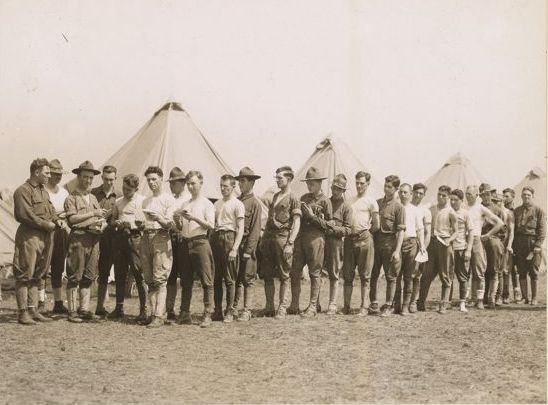
Distribution of Mail Camp Mills, Mineola, L I
National Archives 275f15 RG 165
Ed Note: Many thanks to the State of North Carolina for maintaining and providing online access to their WW1 history.
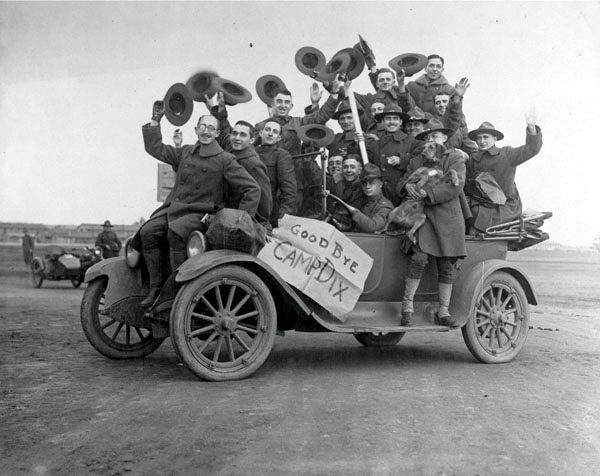
"Soldiers being mustered out at Camp Dix, New Jersey"
By Underwood and Underwood, 1918 National Archives
Camp Bragg:
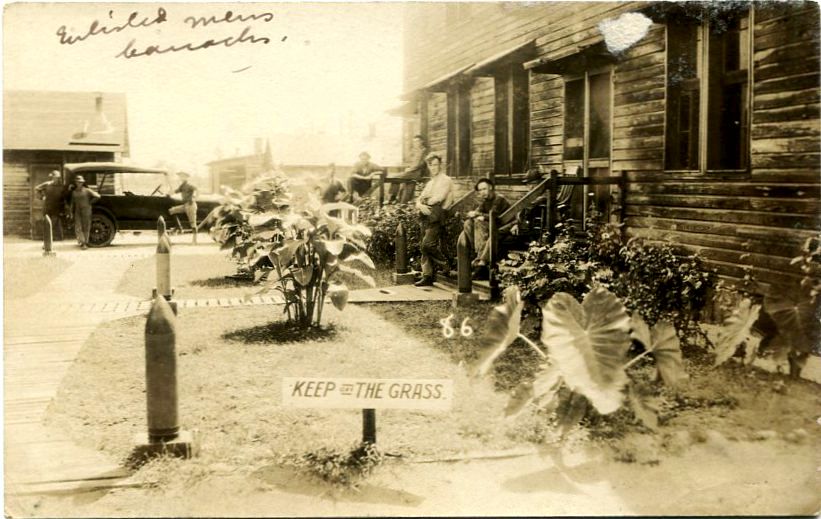
Real-photo postcard of a photograph of unidentified U.S. Army soldiers sitting and standing around the doorways and an automobile outside of the enlisted men’s barracks at Camp Bragg, N.C., taken between 1918 and 1922.
From Fort Bragg Postcard Collection, MMP 10, Miscellaneous Military Papers, Military Collection, State Archives of North Carolina, Raleigh, N.C.
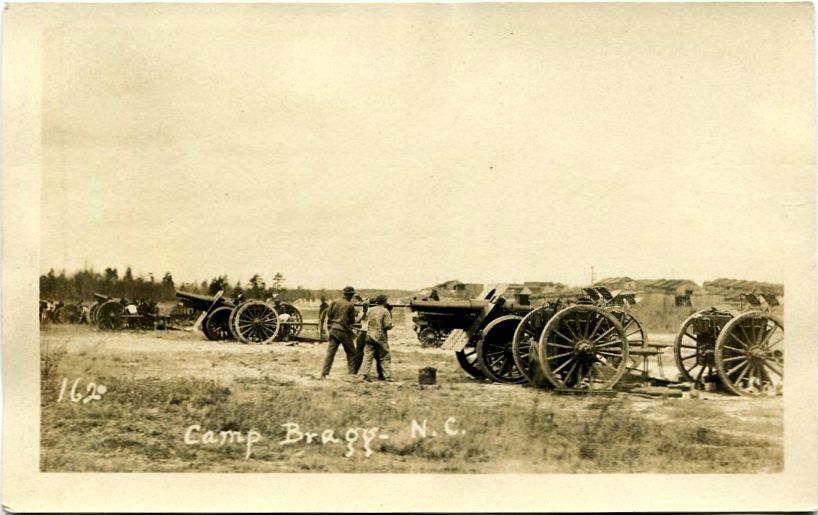
Real-photo postcard of a photograph of an unidentified field artillery crew either cleaning or tamping down the load in the barrel of an artillery gun on the firing range at Camp Bragg, N.C., taken between 1918 and 1922
From Fort Bragg Postcard Collection, MMP 10, Miscellaneous Military Papers, Military Collection, State Archives of North Carolina, Raleigh, N.C.
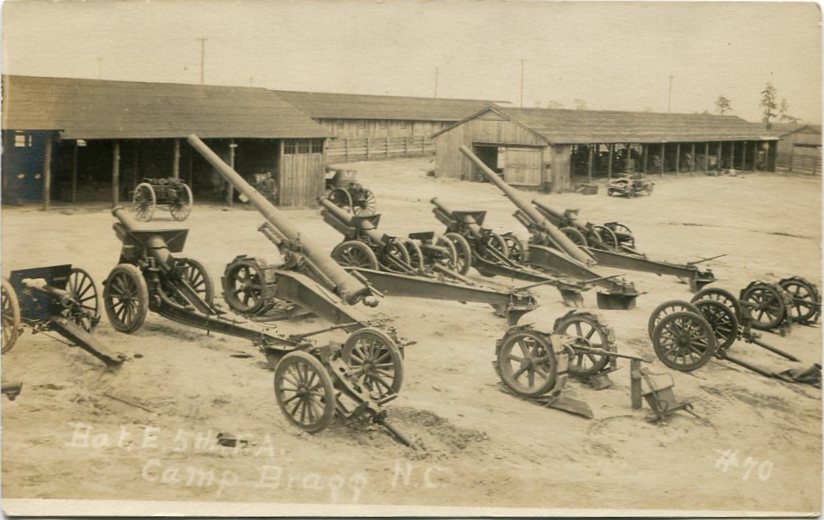
Real-photo postcard of a photograph of the artillery guns of Battery E, 5th Field Artillery Regiment, at Camp Bragg, N.C., taken between 1918 and 1922. A number of the vehicle, cart, and gun buildings are seen in the background.
From Fort Bragg Postcard Collection, MMP 10, Miscellaneous Military Papers, Military Collection, State Archives of North Carolina, Raleigh, N.C.
![Ft Bragg CMTC Balloon Original copy print of a photograph of a Citizens’ Military Training Camps (CMTC) at Fort Bragg, N.C., artillery parade on camp march during the 1920s [circa 1920s].](https://wwvets.org/wp-content/uploads/2020/08/TCFt-Bragg-CMTC-Balloon.jpg)
Original copy print of a photograph of a Citizens’ Military Training Camps (CMTC) at Fort Bragg, N.C., artillery parade on the camp march during the 1920s.
From Frank Hall Collection, MMP 11, Miscellaneous Military Papers, Military Collection, State Archives of North Carolina, Raleigh, N.C.
![Ft Bragg Big gunn Snapshot of several unidentified U.S. Army soldiers, believed to be members of a gun crew, jokingly posing on a large field artillery gun at Fort Bragg, N.C., around the 1920s. Some of the men are sitting on the end or standing along the side of the raised gun barrel [circa 1920s].](https://wwvets.org/wp-content/uploads/2020/08/TCFt-Bragg-Big-gunn.jpg)
Snapshot of several unidentified U.S. Army soldiers, believed to be members of a gun crew, jokingly posing on a large field artillery gun at Fort Bragg, N.C., around the 1920s. Some of the men are sitting on the end or standing along the side of the raised gun barrel.
From Willie H. Mann Photographs, WWI 158, WWI Papers, Military Collection, State Archives of North Carolina, Raleigh, N.C.
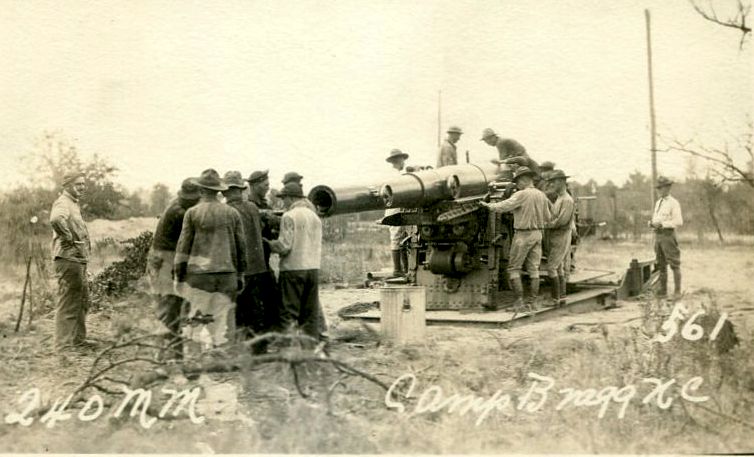
Real-photo postcard of a photograph of an unidentified field artillery crew going through instructions on operating a M1918 240mm howitzer gun at Camp Bragg, N.C., taken between 1918 and 1922.
From Fort Bragg Postcard Collection, MMP 10, Miscellaneous Military Papers, Military Collection, State Archives of North Carolina, Raleigh, N.C.

Group photograph of the 3rd North Carolina Infantry, commanded by Col. Sidney W. Minor, while stationed at Camp Stewart in El Paso, Texas, in 1916. The 3rd North Carolina Infantry was in Texas during General John J. Pershing’s Punitive Expedition against Pancho Villa [Photograph by: J. U. Medley and I. Shulman, Photographers, El Paso.]
From WWI Panoramas Collection, WWI Papers, Military Collection, State Archives of North Carolina, Raleigh, N.C.
Stateside Training Camps locations WW1
Source: War Department (US). Annual report, 1919. Washington: Government Printing Office; 1920. p. 1519.
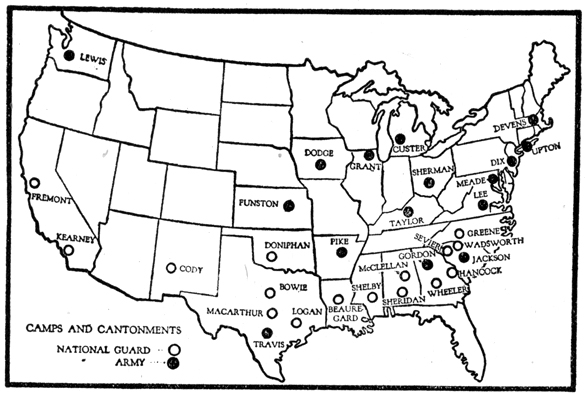
Camp Greene, Charlotte, North Carolina
Established in 1917 and named for Revolutionary War hero Nathanael Greene. Initially, 8,000 troops were housed in tents but soon an infastructure was built to house and train over 65,000 troops. Camp Greene covers 2,500 acres and had 2,000 buildings that included a 2,000-bed hospital, a mile of horse stables, a post office, bakery, and YMCA.
It opened in 1917 and faced the coldest winter on record with heavy rain, snow, sleet, and extreme cold. Most troops were housed in tents built on wooden platforms and faced bitter cold.
The influenza pandemic caused more than 1,200 deaths in a few short weeks.
Camp Greene troops were trained for trench warfare.
![TCCamp Greene saluting Picture postcard of a view of U.S. Army soldiers saluting during a training drill at the U.S. National Guard Cantonment at Camp Greene, N.C., during World War I. Postcard contains message from a man named Getz to Mary E. Early of Nokesville, Virginia, in June 1921 [circa 1910s] [Postcard by: C. T. American Art and Southern Post Card Company, Asheville, N.C.].](https://wwvets.org/wp-content/uploads/2020/08/TCCamp-Greene-saluting.jpg)
Picture postcard of a view of U.S. Army soldiers saluting during a training drill at the U.S. National Guard Cantonment at Camp Greene, N.C., during World War I. Postcard contains a message from a man named Getz to Mary E. Early of Nokesville, Virginia, in June 1921 [circa 1910s] [Postcard by: C. T. American Art and Southern Post Card Company, Asheville, N.C.].
From Hall Photographs and Postcards Collection, MMP 12, Miscellaneous Military Papers, Military Collection, State Archives of North Carolina, Raleigh, N.C.
![TCCamp Greene tents Picture postcard of an aeroplane view of U.S. Army tent areas and camp streets at Camp Greene, N.C., during World War I. Postcard contains message from an Army soldier named John to Murray Upson of New Haven, Connecticut [circa 1910s] [Postcard by: A. M. Simon of New York City].](https://wwvets.org/wp-content/uploads/2020/08/TCCamp-Greene-tents.jpg)
Picture postcard of an aeroplane view of U.S. Army tent areas and camp streets at Camp Greene, N.C., during World War I. Postcard, contains a message from an Army soldier named John to Murray Upson of New Haven, Connecticut [circa 1910s] [Postcard by: A. M. Simon of New York City].
From Hall Photographs and Postcards Collection, MMP 12, Miscellaneous Military Papers, Military Collection, State Archives of North Carolina, Raleigh, N.C.
![TCCamp Greene mess Picture postcard of a view of U.S. Army soldiers in a company mess line at Camp Greene, N.C., during World War I [circa 1910s] [Postcard by: E. C. Kropp Company, Milwaukee, Wisconsin].](https://wwvets.org/wp-content/uploads/2020/08/TCCamp-Greene-mess.jpg)
Picture postcard of a view of U.S. Army soldiers in a company mess line at Camp Greene, N.C., during World War I [circa 1910s] [Postcard by: E. C. Kropp Company, Milwaukee, Wisconsin].
From Hall Photographs and Postcards Collection, MMP 12, Miscellaneous Military Papers, Military Collection, State Archives of North Carolina, Raleigh, N.C.
![TCCamp Greene Base Hospital Picture postcard of a view of a section of the Base Hospital at Camp Greene, N.C., during World War I [circa 1910s] [Postcard by: E. C. Kropp Company, Milwaukee, Wisconsin].](https://wwvets.org/wp-content/uploads/2020/08/TCCamp-Greene-Base-Hospital.jpg)
Picture postcard of a view of a section of the Base Hospital at Camp Greene, N.C., during World War I [circa 1910s] [Postcard by: E. C. Kropp Company, Milwaukee, Wisconsin].
From Hall Photographs and Postcards Collection, MMP 12, Miscellaneous Military Papers, Military Collection, State Archives of North Carolina, Raleigh, N.C.